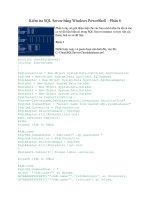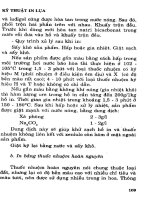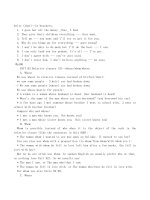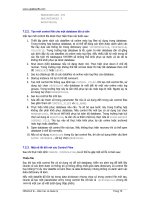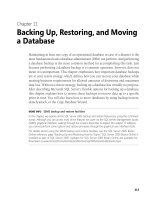advanced sql Functions in Oracle 10G phần 6 ppsx
Bạn đang xem bản rút gọn của tài liệu. Xem và tải ngay bản đầy đủ của tài liệu tại đây (621.78 KB, 42 trang )
Giving:
PRODUCT LOCATION YEAR AMOUNT
Blueberries Pensacola 2005 7650
Blueberries Pensacola 2006 9000
Cotton Pensacola 2005 13600
Cotton Pensacola 2006 16000
Lumber Pensacola 2005 2975
Lumber Pensacola 2006 3500
Then, we will use the MAX aggregate function and a
BETWEEN condition on the RHS:
SELECT product, location, year, s "Year Max"
FROM sales1
WHERE location like 'Pen%'
MODEL
RETURN UPDATED ROWS
PARTITION BY (product)
DIMENSION BY (location, year)
MEASURES (amount s) IGNORE NAV
(s['Pensacola', ANY] = max(s)['Pensacola',year between 2005
and 2006])
ORDER BY product, location, year
Giving:
PRODUCT LOCATION YEAR Year Max
Blueberries Pensacola 2005 9000
Blueberries Pensacola 2006 9000
Cotton Pensacola 2005 16000
Cotton Pensacola 2006 16000
Lumber Pensacola 2005 3500
Lumber Pensacola 2006 3500
We are not constrained to using wildcards on the RHS
calculation of aggregates. In this case we controlled
which rows would be included in the aggregate using
the BETWEEN predicate.
192
The MODEL or SPREADSHEET Predicate in Oracle’s SQL
Revisiting CV with Value Offsets —Revisiting CV with Value Offsets —
Using Multiple MEASURES ValuesUsing Multiple MEASURES Values
We have seen how to use the CV function inside an
RHS expression. The CV function copies the value
from the LHS and uses it in a calculation. We can also
use logical offsets from the current value. For example,
“cv()–1” would indicate the current value minus one.
Suppose we wanted to calculate the increase in sales
for each year, cv(). We will need the sales from the pre
-
vious year to make the calculation, cv()–1. We will
restrict the data for the example; look first at sales in
Pensacola:
SELECT product, location, year, amount
FROM sales1
WHERE location like 'Pen%'
ORDER BY product, location, year
Giving:
PRODUCT LOCATION YEAR AMOUNT
Blueberries Pensacola 2005 7650
Blueberries Pensacola 2006 9000
Cotton Pensacola 2005 13600
Cotton Pensacola 2006 16000
Lumber Pensacola 2005 2975
Lumber Pensacola 2006 3500
We will PARTITION BY product in this example and
we will DIMENSION BY location and year. We will
use two new MEASURES, growth and pct (percent
growth). We will calculate with RULES and display
the two new values. In the MEASURES clause, we will
need the amount value, although it does not appear in
the result set. As before, we will alias “amount” as s to
simplify the RULES statements. Also, we need to add
193
Chapter
|
6
the new result set columns growth and pct, but in the
MEASURES clause, they are preceded by a zero so
they can be aliased. We will use the RETURN
UPDATED ROWS option to limit the output. Here is
the query:
SELECT product, location, year, growth, pct
FROM sales1
WHERE location like 'Pen%'
MODEL
RETURN UPDATED ROWS
PARTITION BY (product)
DIMENSION BY (location, year)
MEASURES (amount s, 0 growth, 0 pct) IGNORE NAV
(growth['Pensacola', year > 2005] = (s[cv(),cv()] -
s[cv(),cv()-1]),
pct['Pensacola', year > 2005]
= (s[cv(),cv()] - s[cv(),cv()-1])/s[cv(),cv()-1])
ORDER BY location, product
Giving:
PRODUCT LOCATION YEAR GROWTH PCT
Blueberries Pensacola 2006 1350 .176470588
Cotton Pensacola 2006 2400 .176470588
Lumber Pensacola 2006 525 .176470588
Let us consider several things in this example. First,
we are using “amount” in the calculation although we
do not report amount directly. Note the syntax of this
RULE:
growth['Pensacola', year > 2005] = (s[cv(),cv()] -
s[cv(),cv()-1])
The RULE says to compute a value for growth and
hence growth appears on the LHS preceding the
brackets. The RULE uses location and year to define
the rows in the table for which growth will be
194
The MODEL or SPREADSHEET Predicate in Oracle’s SQL
computed. Note that the calculation is based on
amounts, aliased by s, which appears as the computing
value on the RHS before the brackets.
Remember that in the original explanation for this
RULE:
(new_amt['Pensacola', ANY]= new_amt['Pensacola',
currentv(amount)]*2)
We said:
The new_amt on the LHS before the brackets
['Pen ] means that we will compute a value for
new_amt. The new_amt on the RHS before the
brackets means we will use new_amt values
(amount values) to compute the new values for
new_amt on the LHS.
In this example, we have created a new variable on the
LHS (growth) and used the old variable (s)onthe
RHS. Syntactically and logically, we must mention
both the new variable and the old one in the
MEASURES clause. We are not bound to report in the
result set the values we use in the MEASURES clause.
On the other hand, to use the values in the RULES we
have to have defined them in MEASURES. To make
the new variable (growth, for example) numeric, we
precede the “declaration” of growth with a zero in the
MEASURES clause.
Another quirk of this RULE:
growth['Pensacola', year > 2005] = (s[cv(),cv()] -
s[cv(),cv()-1])
is that we have used logical offsets in the calculation.
Rather than ask for amounts (s) for calculation of a
given growth for a given year, we offset the current
value by –1 in the difference expression. What we are
saying here is that for a particular year, we will use the
195
Chapter
|
6
values for that year and the previous year. So, for 2006
we compute the growth for Pensacola as the “cv(),cv()”
minus the “cv(),cv()–1”, which would be (using amount
rather than its alias, s):
amount('Pensacola',2006) – amount('Pensacola',2005)
The other calculation, “pct,” is a bit more complex, but
follows the same syntactical logic as the “growth”
calculation.
We used the alias for amount for a shorthand nota
-
tion, but the query works just as well and perhaps
reads more clearly if we do not use the alias for
amount:
SELECT product, location, year, growth, pct
FROM sales1
WHERE location like 'Pen%'
MODEL
RETURN UPDATED ROWS
PARTITION BY (product)
DIMENSION BY (location, year)
MEASURES (amount, 0 growth, 0 pct) IGNORE NAV
(growth['Pensacola', year > 2005] = (amount[cv(),cv()] -
amount[cv(),cv()-1]),
pct['Pensacola', year > 2005]
= (amount[cv(),cv()] - amount[cv(),cv()-1])/
amount[cv(),cv()-1])
ORDER BY location, product
Giving:
PRODUCT LOCATION YEAR GROWTH PCT
Blueberries Pensacola 2006 1350 .176470588
Cotton Pensacola 2006 2400 .176470588
Lumber Pensacola 2006 525 .176470588
The use of the alias here is a trade-off between under
-
standability and brevity.
196
The MODEL or SPREADSHEET Predicate in Oracle’s SQL
As an aside, this result could have been had with a
traditional (albeit arguably more complex) self-join:
SELECT a.product, a.location, b.year,
b.amount amt2006, a.amount amt2005,
b.amount - a.amount growth,
(b.amount - a.amount)/a.amount pct
FROM sales1 a, sales1 b
WHERE a.year = b.year -1
AND a.location LIKE 'Pen%'
AND b.location LIKE 'Pen%'
AND a.product = b.product
ORDER BY product
Giving:
PRODUCT LOCATION YEAR AMT2006 AMT2005 GROWTH PCT
Blueberries Pensacola 2006 9000 7650 1350 .176470588
Cotton Pensacola 2006 16000 13600 2400 .176470588
Lumber Pensacola 2006 3500 2975 525 .176470588
Having developed the example for one location, we can
expand the MODEL statement to get the growth vol-
ume and percents for all locations using the ANY
wildcard and commenting out the WHERE clause of
the core query:
SELECT product, location, year, growth, pct
FROM sales1
WHERE location like 'Pen%'
MODEL
RETURN UPDATED ROWS
PARTITION BY (product)
DIMENSION BY (location, year)
MEASURES (amount s, 0 growth, 0 pct) IGNORE NAV
(growth[ANY, year > 2005] = (s[cv(),cv()] - s[cv(),cv()-1]),
pct[ANY, year > 2005] = (s[cv(),cv()] - s[cv(),
cv()-1])/s[cv(),cv()-1])
ORDER BY location, product
197
Chapter
|
6
Giving:
PRODUCT LOCATION YEAR GROWTH PCT
Cotton Mobile 2006 2400 .111111111
Lumber Mobile 2006 280 .111111111
Plastic Mobile 2006 3200 .111111111
Blueberries Pensacola 2006 1350 .176470588
Cotton Pensacola 2006 2400 .176470588
Lumber Pensacola 2006 525 .176470588
Perhaps there is a lesson in query development here in
that it is easier to see results if the original data is fil
-
tered before we attempt to compute all values.
Ordering of the RHSOrdering of the RHS
When a range of cells is in the result set, ordering may
be necessary when computing the values of the cells.
Consider this derivative table created from previous
data and enhanced:
Ordered by year ascending:
LOCATION PRODUCT AMOUNT YEAR
Mobile Cotton 19872 2004
Mobile Cotton 21600 2005
Mobile Cotton 24000 2006
Ordered by year descending:
LOCATION PRODUCT AMOUNT YEAR
Mobile Cotton 24000 2006
Mobile Cotton 21600 2005
Mobile Cotton 19872 2004
198
The MODEL or SPREADSHEET Predicate in Oracle’s SQL
The MODEL statement creates a virtual table from
which it calculates results. If the MODEL statement
updates the result that appears in the result set, the
result calculation may depend on the order in which the
data is retrieved. As we know, one can never depend on
the order in which data is actually stored in a relational
database. Consider the following examples where the
RULES are made to give us the sum of the amounts
for the previous two years, for either year first, based
on different orderings:
SELECT product, t, s
FROM sales2
MODEL
RETURN UPDATED ROWS
PARTITION BY (location)
DIMENSION BY (product, year t)
MEASURES (amount s)
(s['Cotton', t>=2005] ORDER BY t asc =
sum(s)[cv(),t between cv(t)-2 and cv(t)-1])
ORDER BY product
Giving:
PRODUCT T S
Cotton 2006 39744
Cotton 2005 19872
Note that the PARTITION BY statement is com
-
mented out, as the table contains only one location and
hence partitioning is not necessary. Next, we compute
a new value for s based on the sum of other values of s
where on the RHS we sum over years cv()–1 and
cv()–2. Second, we have added an ordering clause to the
LHS to prescribe how we want to compute our new val
-
ues — ascending by year in this case.
199
Chapter
|
6
For ('Cotton',2006), you expect the new value of s to
be the sum of the values for 2005 and 2004 (19872 +
21600) = 41472. You expect that the sum for 2005
would be just 2004 because there is no 2003. But
instead, we get an odd value for 2006. What is going on
here? The problem here is that in the calculation, we
need to order the “input” to the RULES. In the above
case, we have ordered the year to be ascending on the
LHS, so 2005 was calculated first. 2005 was correct as
there was no 2003 and so the new value for 2005 was
reported as the value for 2004:
s['Cotton', t>=2005] = sum(s)[cv(),t between cv(t)-2 and
cv(t)-1]
Becomes:
s['Cotton', 2005] = sum(s)[cv(),t between 2003 and 2004]
s['Cotton', 2005] = s['Cotton', 2004] + s['Cotton', 2003]
s['Cotton', 2005] = 19872+0=19872
When calculating 2006, the statement becomes:
s['Cotton', 2006] = sum(s)[cv(),t between 2004 and 2005]
s['Cotton', 2006] = s['Cotton', 2005] + s['Cotton', 2004]
But 2005 has been recalculated due to our ordering. So,
the calculation for 2006 becomes:
s['Cotton', 2005] = 19872 + 19872 = 39744
Now look what happens if the LHS years are in
descending order:
SELECT product, t, s
FROM sales2
MODEL
RETURN UPDATED ROWS
PARTITION BY (location)
DIMENSION BY (product, year t)
200
The MODEL or SPREADSHEET Predicate in Oracle’s SQL
MEASURES (amount s)
(s['Cotton', t>=2005] ORDER BY t desc =
sum(s)[cv(),t between cv(t)-2 and cv(t)-1])
ORDER BY product
Gives:
PRODUCT T S
Cotton 2006 41472
Cotton 2005 19872
We get the correct answers because 2006 is recalcu
-
lated based on original values for 2005 and 2004. Then,
2005 is recalculated.
Because of the ordering problem, in some state-
ments where ordering is necessary, we may get an
error if no ordering is specified.
SELECT product, t, s
FROM sales2
MODEL
RETURN UPDATED ROWS
PARTITION BY (location)
DIMENSION BY (product, year t)
MEASURES (amount s)
(s['Cotton', t>=2005] = ORDER BY t desc =
sum(s)[cv(),t between cv(t)-2 and cv(t)-1])
ORDER BY product
SQL> /
Gives:
FROM sales2
*
ERROR at line 2:
ORA-32637: Self cyclic rule in sequential order MODEL
When no ORDER BY clause is specified, you might
think that the ordering specified by the DIMENSION
should take precedence; however, it is far better to
201
Chapter
|
6
dictate the order of the calculation if it would make a
difference, as it did in this case.
AUTOMATIC versus SEQUENTIALAUTOMATIC versus SEQUENTIAL
ORDER
Again, consider a partition of the Sales2 table but this
time, we will use even sales amounts to make mental
calculations easier:
SELECT * FROM sales2
WHERE product = 'Lumber'
ORDER BY year
Gives:
LOCATION PRODUCT AMOUNT YEAR
Mobile Lumber 2000 2005
Mobile Lumber 3000 2006
Then consider using a SPREADSHEET (MODEL)
clause to forecast 2005 sales as 10% higher than the
existing value and 2006 sales as 20% higher:
SELECT product, t, orig, x projected
FROM sales2
MODEL
RETURN UPDATED ROWS
DIMENSION BY (product, amount orig, year t)
MEASURES (amount x)
RULES
(x['Lumber',ANY,2005] = x[cv(),cv(),cv()]*1.1,
x['Lumber',ANY,2006] = x[cv(),cv(),cv()]*1.2)
ORDER BY t
202
The MODEL or SPREADSHEET Predicate in Oracle’s SQL
Gives:
PRODUCT T ORIG PROJECTED
Lumber 2005 2000 2200
Lumber 2006 3000 3600
In this example, we are simply updating rows based on
a formula (a set of RULES). The amount calculated for
2005 is based on 2005 values, and the same is true for
2006.
Another way to write this statement could look like
this:
SELECT product, t, x orig, projected
FROM sales2
MODEL
RETURN UPDATED ROWS
DIMENSION BY (product, year t)
MEASURES (amount x, 0 projected)
RULES
(projected['Lumber', 2005] = x[cv(), cv()]*1.1,
projected['Lumber', 2006] = x[cv(), cv()]*1.2)
ORDER BY t
Giving:
PRODUCT T ORIG PROJECTED
Lumber 2005 2000 2200
Lumber 2006 3000 3600
In the second version we compute “projected” based on
“amount” (aliased by x).
Now suppose we decide to compute the projected
values such that 2005 is based on a 10% increase and
we compute 2006 based on 20% more than the pro
-
jected value in 2005. It makes a difference whether we
compute the 2005 projected value before we compute
2006, since 2006 is based on the projected value of 2005.
203
Chapter
|
6
We could tackle this problem using ordering on the
LHS as before, but we will do this a different way by
explicitly calculating rows.
Consider this statement:
SELECT product, t, x orig, projected
FROM sales2
MODEL
RETURN UPDATED ROWS
DIMENSION BY (product, year t)
MEASURES (amount x, 0 projected)
RULES
(projected['Lumber', 2005] = x[cv(), cv()]*1.1,
projected['Lumber', 2006] = projected[cv(), cv()-1]*1.2)
ORDER BY t
Giving:
PRODUCT T ORIG PROJECTED
Lumber 2005 2000 2200
Lumber 2006 3000 2640
Here, the projected value for 2006 is 2640 which is 1.2 *
2200 (projected 2006 is 20% more than projected 2005).
But suppose the RULES were reversed:
SELECT product, t, x orig, projected
FROM sales2
MODEL
RETURN UPDATED ROWS
DIMENSION BY (product, year t)
MEASURES (amount x, 0 projected)
RULES
(projected['Lumber', 2006] = projected[cv(), cv()-1]*1.2,
projected['Lumber', 2005] = x[cv(), cv()]*1.1)
ORDER BY t
204
The MODEL or SPREADSHEET Predicate in Oracle’s SQL
Giving:
PRODUCT T ORIG PROJECTED
Lumber 2005 2000 2200
Lumber 2006 3000 0
Here, when we compute the 20% increase in 2006 based
on the projected 2005 value, we get zero because “pro
-
jected 2005” has not been computed yet! The RULES
say to compute 2006, then compute 2005. A way around
this is to tell SQL that you want to compute these val
-
ues automatically; let the SQL engine determine which
needs to be computed first. The phrase AUTOMATIC
ORDER may be put in the RULES like this:
SELECT product, t, x orig, projected
FROM sales2
MODEL
RETURN UPDATED ROWS
DIMENSION BY (product, year t)
MEASURES (amount x, 0 projected)
RULES AUTOMATIC ORDER
(projected['Lumber', 2006] = projected[cv(), cv()-1]*1.2,
projected['Lumber', 2005] = x[cv(), cv()]*1.1)
ORDER BY t
Giving:
PRODUCT T ORIG PROJECTED
Lumber 2005 2000 2200
Lumber 2006 3000 2640
If you actually wanted your RULES to be evaluated in
the order in which they are written, then the appropri
-
ate phrase would be SEQUENTIAL ORDER:
205
Chapter
|
6
SELECT product, t, x orig, projected
FROM sales2
MODEL
RETURN UPDATED ROWS
DIMENSION BY (product, year t)
MEASURES (amount x, 0 projected)
RULES SEQUENTIAL ORDER
(projected['Lumber', 2006] = projected[cv(), cv()-1]*1.2,
projected['Lumber', 2005] = x[cv(), cv()]*1.1)
ORDER BY t
Giving:
PRODUCT T ORIG PROJECTED
Lumber 2005 2000 2200
Lumber 2006 3000 0
When writing RULES, particularly if the RULES are
more complex than this example, you may phrase
RULES to be executed either way. It is necessary to
know which RULE ordering is to be applied when one
calculation depends on another.
The FOR Clause, UPDATE, andThe FOR Clause, UPDATE, and
UPSERT
Consider this version of the Sales table (Sales2). In this
version we display the amount and the amount multi
-
plied by 2:
SELECT product, amount, amount*2, year
FROM sales2
WHERE product = 'Cotton'
ORDER BY product, year
206
The MODEL or SPREADSHEET Predicate in Oracle’s SQL
Giving:
PRODUCT AMOUNT AMOUNT*2 YEAR
Cotton 19872 39744 2004
Cotton 21600 43200 2005
Cotton 24000 48000 2006
In most of the examples we have offered, we used val
-
ues on the RHS to calculate new, updated values on the
LHS. For example:
SELECT product, s "Amount x 2", t
FROM sales2
SPREADSHEET
RETURN UPDATED ROWS
PARTITION BY (location)
DIMENSION BY (product, year t)
MEASURES (amount s) IGNORE NAV
(s['Cotton', t ]
ORDER BY t
= s[cv(), cv(t)]*2)
ORDER BY product, t
Gives:
PRODUCT Amount x 2 T
Cotton 39744 2004
Cotton 43200 2005
Cotton 48000 2006
In this example, we simply ask for a recomputation of
the amount for each year in the table with the LHS ref
-
erencing Cotton and whichever year (alias t) comes up.
The RHS calculation is based on the current values in
that row — “s[cv(), cv(t)]*2).” As before, the first cv()
refers to Product as it is specified first in the
DIMENSION BY clause. The second argument on
both sides also references the ordering specified by
207
Chapter
|
6
DIMENSION BY. Here, we say that the column s,
aliased by Amount x 2, is updated. A new value is com
-
puted and put in the appropriate place in the result set,
replacing the original values of s.
If we use a symbolic reference to the year we get
the same result:
SELECT product, s, t
FROM sales2
SPREADSHEET
RETURN UPDATED ROWS
PARTITION BY (location)
DIMENSION BY (product, year t)
MEASURES (amount s) IGNORE NAV
(s['Cotton', t between 2002 and 2007]
ORDER BY t
= s[cv(), cv(t)]*2)
ORDER BY product, t
Gives:
PRODUCT S T
Cotton 39744 2004
Cotton 43200 2005
Cotton 48000 2006
In this case, we have asked for the years between 2002
and 2007. For those years where no value in this range
exists we get no result. We get updated cells for the
places where the calculation is made.
Now, suppose we want to have values for the years
2002 through 2007 whether data exists for those years
or not. We can force the LHS to create rows for those
years with a FOR statement. When we force the LHS
to create values, the value is carried over to the RHS
with the CV function. The syntax of the FOR state
-
ment is:
208
The MODEL or SPREADSHEET Predicate in Oracle’s SQL
FOR column-name IN (appropriate set)
or
FOR column-name IN (SELECT clause with a result set matching
column type)
Suppose we use this FOR on the LHS:
SELECT product, s, t
FROM sales2
SPREADSHEET
RETURN UPDATED ROWS
PARTITION BY (location)
DIMENSION BY (product, year t)
MEASURES (amount s) IGNORE NAV
(s['Cotton', FOR t IN (2003, 2004, 2005, 2006, 2007)]
= s[cv(), cv(t)]*2)
ORDER BY product, t
This gives:
PRODUCT S T
Cotton 0 2003
Cotton 39744 2004
Cotton 43200 2005
Cotton 48000 2006
Cotton 0 2007
When using a FOR loop, control can be exercised as to
whether or not one wants to see the rows for which the
data does not apply by using the UPSERT or
UPDATE option. UPSERT means “update or insert”
and is the default.
SELECT product, s, t
FROM sales2
SPREADSHEET
RETURN UPDATED ROWS
209
Chapter
|
6
PARTITION BY (location)
DIMENSION BY (product, year t)
MEASURES (amount s) IGNORE NAV
RULES UPSERT
(s['Cotton', FOR t IN (2003, 2004, 2005, 2006, 2007)]
= s[cv(), cv(t)]*2)
ORDER BY product, t
Giving:
PRODUCT S T
Cotton 0 2003
Cotton 39744 2004
Cotton 43200 2005
Cotton 48000 2006
Cotton 0 2007
SQL> ed
Wrote file afiedt.buf
If UPDATE is specified, then only updated rows are
presented:
SELECT product, s, t
FROM sales2
SPREADSHEET
RETURN UPDATED ROWS
PARTITION BY (location)
DIMENSION BY (product, year t)
MEASURES (amount s) IGNORE NAV
RULES UPDATE
(s['Cotton', FOR t IN (2003, 2004, 2005, 2006, 2007)]
= s[cv(), cv(t)]*2)
ORDER BY product, t
210
The MODEL or SPREADSHEET Predicate in Oracle’s SQL
Giving:
PRODUCT S T
Cotton 39744 2004
Cotton 43200 2005
Cotton 48000 2006
Iteration
The MODEL statement also allows us to use iteration
to calculate values. Iteration calculations are often used
for approximations. As a first example of syntax and
function, consider this:
SELECT s, n, x FROM dual
MODEL
DIMENSION BY (1 x)
MEASURES (50 s, 0 n)
RULES ITERATE (3)
(s[1] = s[1]/2,
n[1] = n[1] + 1)
Gives:
SNX
6.25 3 1
The statement has three values in the result set: s, n,
and x. The MODEL uses DIMENSION BY (1 x). The
s as used in this statement requires a subscript. The
construct (1 x) in the dimension clause uses 1 arbi
-
trarily; the 1 is used for the “subscript” for s in the
RULES. The MEASURES clause defines two aliases
that we will display in the result set, s and n. Initial val
-
ues for s and n are 50 and 0 respectively.
211
Chapter
|
6
The RULES clause says we will ITERATE exactly
three times. After the first iteration, the value of s[1]
becomes 50/2, or 25; after the second iteration, s[1]
becomes 25/2 = 12.5; and on the third iteration, s[1]
becomes 12.5/2 = 6.25. Had we chosen some other
number for x, we’d get the same result for s and n, but
we just have to be consistent in writing the rules so
that the information in the brackets agrees with the
initial value for x:
SELECT s, n, x FROM dual
MODEL
DIMENSION BY (37 x)
MEASURES (50 s, 0 n)
RULES ITERATE (3)
(s[37] = s[37]/2,
n[37] = n[37] + 1)
Gives:
SNX
6.25 3 37
We can include an UNTIL clause in our iteration to
terminate the loop like this:
SELECT s, n, x FROM dual
MODEL
DIMENSION BY (1 x)
MEASURES (50 s, 0 n)
RULES ITERATE (20) UNTIL (s[1]<=1)
(s[1] = s[1]/2,
n[1] = n[1] + 1)
Gives:
SNX
.78125 6 1
212
The MODEL or SPREADSHEET Predicate in Oracle’s SQL
In this case, we place a maximum value on iterations of
20. We decided to terminate the iteration when the
value of s[1] is less than or equal to 1. The iteration
proceeded like this:
Step S N
Start 50 0
125 1
2 12.5 2
3 6.25 3
4 3.125 4
5 1.5625 5
6 0.71825 6
We can also compare a value with its predecessor in the
iteration calculation like this:
SELECT s, n, x FROM dual
MODEL
DIMENSION BY (1 x)
MEASURES (50 s, 0 n)
RULES ITERATE (80) UNTIL (previous(s[1])-s[1]<=0.25)
(s[1] = s[1]/2,
n[1] = n[1] + 1)
Giving:
SNX
.1953125 8 1
This time we used a maximum value of 80 for itera
-
tions. We decided to terminate the iteration when the
difference between the previous value of s[1] and the
new value of s[1] is less than or equal to 0.25. The itera
-
tion proceeded like this:
213
Chapter
|
6
Step S N
Start 50 0
125 1
2 12.5 2
3 6.25 3
4 3.125 4
5 1.5625 5
6 0.71825 6
7 0.3906 7
8 0.1953 8
Note that the iteration stopped when the difference
between the previous value and new value was less
than 0.25 (0.39 – 0.19 = 0.20).
A Square Root Iteration ExampleA Square Root Iteration Example
We will now create an example where we guess a
square root and then use the guess to approach the
actual value. To use the ITERATE command like this,
we first create a table with labels and values:
DESC square_root
Gives:
Name Null? Type
LABELS VARCHAR2(20)
X NUMBER(8,2)
We put values in the table where:
SELECT * FROM square_root
214
The MODEL or SPREADSHEET Predicate in Oracle’s SQL
Gives:
LABELS X
original 21.000
root 10.000
Here, we are going to try to find the square root of
original whose value is 21. We predefined the column
formatting here to be 9999999.999, so we get three dec
-
imal digits of precision. The value for root is a guess
(and not a very good one). For our first try at getting
the root, we will use 1,000 iterations. We hope to
approximate the value of the root by computing a new
value in each iteration based on the old value plus a
correction factor. We will choose a correction constant
(0.005) to use in computing the correction factor so that
the iteration will proceed like this:
Step Guess N
Start 10 0
New value = 10 + (21 – (10*10)) * 0.005
= 10 + (-79) * 0.005
= 10 – 0.395
= 9.605
New value = 9.605 + (21 – (9.605*9.605)) * 0.005
= 9.605 + (-71.25) * 0.005
= 9.05 – 0.356
= 9.248
etc.
The method relies on the fact that the correction factor
approaches the original value and as it gets closer, the
correction gets smaller. In this technique we have a
choice of the correction constant. The size of the
215
Chapter
|
6
correction constant affects how fast one wants to
approach convergence, which in turn affects accuracy
as we will see. If a larger correction constant were
used, convergence would be quicker, but perhaps not
as accurate.
The SELECT statement to calculate the square
root looks like this:
SELECT labels, x
FROM square_root
MODEL IGNORE NAV
DIMENSION BY (labels)
MEASURES (x)
RULES SEQUENTIAL ORDER
ITERATE (1000)
(x['root'] = x['root'] + ((x['original'] –
(x['root']*x['root']))*0.005),
x['Number of iterations'] = ITERATION_NUMBER + 1)
Giving:
LABELS X
original 21.000
root 4.583
Number of iterations 1000.000
This query uses the MODEL syntax we have seen pre
-
viously. We can skip the PARTITION BY because we
have only one set of data. We DIMENSION BY the
labels and compute values based on the “X” values in
the Square_root table, hence MEASURES (x).
In line 7 we instruct the statement to execute 1,000
times to try to find the root. Let’s dissect this state
-
ment a bit:
(x['root'] = x['root'] + ((x['original'] –
(x['root']*x['root']))*0.005)
216
The MODEL or SPREADSHEET Predicate in Oracle’s SQL
